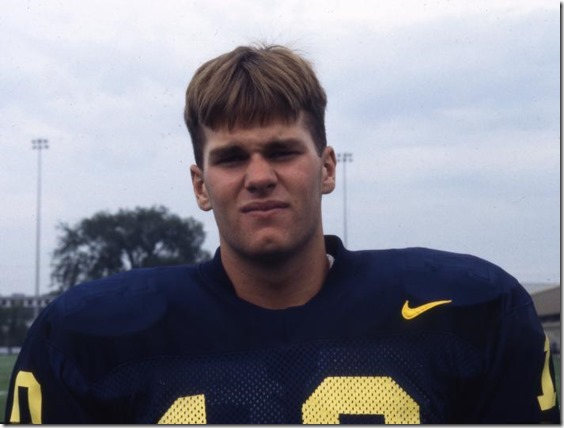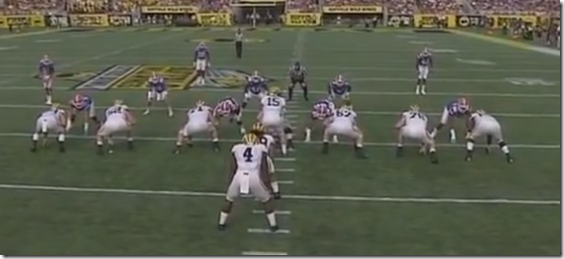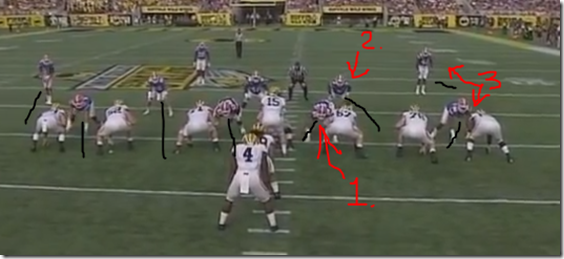tight ends
It’s tough to see what they’ll become [UM Bentley Library]
So yesterday came and went the way it went. The SEC cheats, Michigan’s a tougher sell right now for reasons, yada yada—those who choose to rend garments or yell at the folks wearing tatters have plenty of threads to do so in. Let’s talk about the guys Michigan got.
As it so happens I keep a database of Michigan recruits that goes back to the 1993 class, and that gives us a chance to put all the new guys in context. Shall we?
QUARTERBACK
Shea Patterson is a transfer but let’s start with him for we can have nice things reasons. Also because he was one of the highest-rated quarterbacks out of high school to ever come here:
Shea in 2016 was the #1 Dual Threat or #1 QB to everybody, and between third and 15th overall. Quarterbacks ranked in the Top 5 overall tend to have some real talent—nobody doubts Mallett’s arm. A year of starting in the SEC should put Shea in good shape to challenge for the top job this season, provided the NCAA waives the transfer year. Yay for five-star quarterbacks!
Joe Milton comes in as a project, though one with significant upside. That kind of player usually creates a large amount of disagreement among the recruiting sites and it would appear that’s the case with Joe:
ESPN rated him the highest, which is a bit of a red flag since they tend to fire and forget. Scout had him one of their highest three-stars (before they merged with 247) and Rivals had him a solid 4-star. 247 was down relative to the others. The result is somewhere between Dylan McCaffrey (4.31 average star rating) and Alex Malzone, and closer to the latter. His late fall on 247 dropped him to 16th in the composite score. Some guys you’ve probably heard of who’ve fallen around that range in past years include Maryland’s Kasim Hill (2017), Northwestern’s Clayton Thorson, Wisconsin’s Bart Houston, ND’s Everett Golson, and Messiah deWeaver, Brian Lewerke, and Andrew Maxwell of MSU.
I also tried to find a Harbaugh comp and came up with 2009 Stanford recruit Josh Nunes. Like Milton, Nunes put up big high school stats with a low completion percentage. He wasn’t much of a runner. From my Hall of Harbaugh Quarterbacks piece from a few years ago:
Josh Nunes, the 9th pro-style QB and 139th overall player according to the 247 composite. Nunes was a prolific passer in high school (6,306 yards and 52 TDs in 34 starts) who on Harbaugh’s recommendation added running (3.1 YPA with sacks included) to his reads as a senior. Nunes was heir apparent to Andrew Luck but lost his job to Kevin Hogan while out with a foot injury in 2012, and lost his career to a freak pectoral injury in 2013.
Also the greatest QB of all time was rated around this spot in 1995, but that was 1995.
[Hit THE JUMP for the rest of the offense]
In January I drew up two running plays from Harbaugh's masterful 1st quarter drive against Florida. In both plays Michigan found room to run despite the Gators scheming to attack inside runs, either by blitzing a linebacker or putting DTs in both "A" gaps (the gaps between the center and his guards).
Michigan also used its passing game to attack that defensive strategy, and true to Harbaugh, they did it with tight ends. Let's see how.
The setup:
Rudock will call a play three plays in the huddle and pick one at the line. At that point Harbaugh quarterbacks will often decide where the ball is going by subtle things the defense does with its alignment. You can't trust a defense to attack the way they show, but they do betray some things. Apologies if this sounds like Dora (I work from home with a toddler, okay?!?) but can you spot what the defense is aligning for?
1. That DT isn't in a standard 3-tech position. Both DTs are in a 2i, i.e. lined up on a guard's shoulder. Again, Florida is srsly about taking away those inside runs.
2. The LBs are squeezed in, more evidence that they're selling out against interior runs, which isn't so bad of an idea given Michigan's got Houma and Smith—two runners who do most of their damage going north-south—in the backfield. Guessing who's got what gap isn't easy since the MLB doesn't seem to have one. On the other hand the SAM I'm pointing at here isn't really in position to defend a quick-releasing TE. Meaning the safety to that side is engaged either in a zone or man coverage over there (i.e. not free to roam). Good to know.
3. The ends are both playing 6i, off their respective tight ends' inside shoulders. This suggests some defensive backs have edge responsibility, with the MLB a free hitter. This is suggesting a 9-man front. Perhaps those ends are expected to engage and delay the release of their tight ends, but it's doubtful either would have more than flat coverage against the TEs on a pass play; if those tight ends do release downfield those same edge defenders hangout out on the wings become pass defenders.
Considering the things Michigan wants to do with its offense, this seems pretty sound. Is it accurate though?
[After the jump: there's always a crack]
Previously: Podcast 6.0. The Story. Quarterback. Running back. Wide Receiver.

Butt don't fail me now [Adam Glanzman]
Depth Chart
| Fullback | Yr. | U-back | Yr. | Tight End | Yr. | Flex | Yr. |
|---|---|---|---|---|---|---|---|
| Joe Kerridge | Jr.* | Khalid Hill | Fr.* | AJ Williams | Jr. | Jake Butt | So. |
| Sione Houma | Jr. | Wyatt Shallman | Fr.* | Keith Heitzman | Jr.* | Ian Bunting | Fr. |
| Bobby Henderson | So.* | -- | -- | -- | -- |
Just when we'd split out the various gradations in blocky-catchy guys into its own section of the preview, Al Borges had to go and get himself fired. Cumong, man.
They're all still on the roster and Michigan's going to try to use them so we're sticking with it. This section of the preview consists of everyone who isn't quite a skill position player and isn't quite an offensive linemen. Let's reprise last year's explanation of what is what to orient ourselves:
- FULLBACK: a man with a steel plated head who runs into linebackers, gets two carries in his career, and has six catches. See: Kevin Dudley.
- U-BACK: A "move" tight end who motions all about, rarely lines up on the actual line of scrimmage, often goes from fullback to a flared spot or vice versa, and operates as more of a receiver than the fullback. Must be a credible threat to LBs; ends career with 40 catches. See: Aaron Shea.
- TIGHT END: Larger that the U-back, the tight end is a tight end who is actually tight to the end of the line. He comes out, lines up next to a tackle, helps him win blocks, and clobberates linebackers at the second level. He goes out into patterns as well, and may end his career with 40 catches himself. See: Tyler Ecker.
- FLEX: Sort of like the U-back in that he rarely lines up on the line of scrimmage itself, but if he motions away from his spot near the line, it's not to fullback but wide receiver. They get a billion catches and break Jim Mandich's record eventually. See: every ND tight end ever.
And of course many of these people bleed into other categories. Think of these position designations as Gaussian distributions in close proximity to each other.
FULLBACK
![kerridgejoe2[1] kerridgejoe2[1]](http://mgoblog.com/sites/mgoblog.com/files/images/Preview-2014-Tight-End_1359B/kerridgejoe21.jpg)
Kerridge hits his upperclass years, also linebackers [Maize and Blue News]
RATING: 4
Same guys, potentially less of a role. Doug Nussmeier comes from a one-back coaching tree, and one-back guys are usually a lot more interested in putting two tight ends on the field than a fullback, because fullbacks don't threaten vertically. Given the situation at tight end and the need to bash out a yard or three on the regular, these guys will still be involved. Just maybe not quite as much.
JOE KERRIDGE remains the starter here and should hold on to that designation. It seems like he's been around forever already and he's still got a year left after this one; now is the time for him to start imposing himself on opponents. He did a fair job of doing so last year:
| Opponent | + | - | TOT | Note |
|---|---|---|---|---|
| CMU | 4.5 | - | 4.5 | FBs did well. |
| Notre Dame | 7.5 | 1 | 6.5 | Isos were a high point. |
| Akron | 2 | - | 2 | Blocks got cut away from. |
| UConn | 1.5 | 2 | -0.5 | Not heavily involved. |
| Minnesota | 6 | 3.5 | 2.5 | Let some guys under him. |
| Penn State | 1 | 0.5 | 0.5 | Blocks couldn't even become relevant. |
| Indiana | 2.5 | 1 | 1.5 | |
| MSU | - | - | - | DNC |
| Nebraska | 6.5 | 3.5 | 3 | Got good movement. |
| NW | 3 | 1.5 | 1.5 | Soon to be a WR. |
| Iowa | 4.5 | 1 | 3.5 | Good game, quasi third-down back. |
When the blocking was good enough to make him relevant he did his job, and did it well. It was not all terrific, as he had some questionable plays against Minnesota:
But by the end of the year he was taking a bunch of snaps as a pass protector on throwing downs, acting as Gardner's lead back on occasion, and even catching things out of the backfield. I didn't chart the OSU game but I did review it and Kerridge had a quality day highlighted by this thunderous block:
My God man. I heard that this place's Heap of Smoked Linebacker was excellent, but the descriptions do not do it justice. That is Dudley-worthy there.
Nussmeier isn't likely to deviate from his belief that tight ends on or near the line of scrimmage are much more threatening to a defense than fullbacks, but when Michigan absolutely must scatter a linebacker's equipment across the field, Kerridge will be the weapon of choice.
[After THE JUMP: I googled Jake Butt's name so by god you are going to read the things I have to say about Jake Butt.]





82